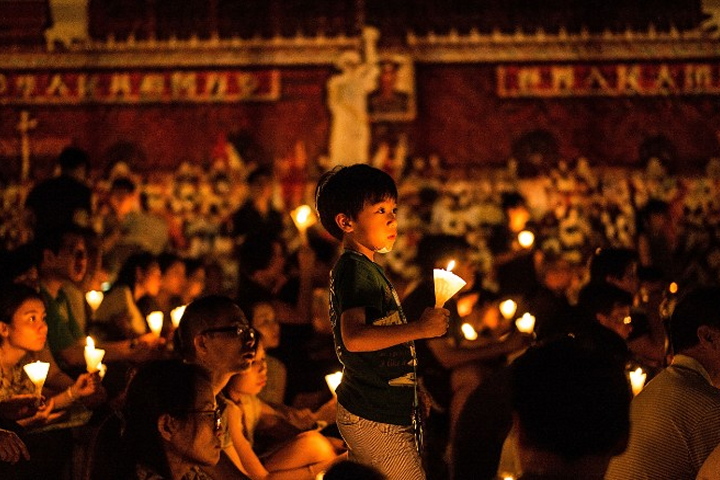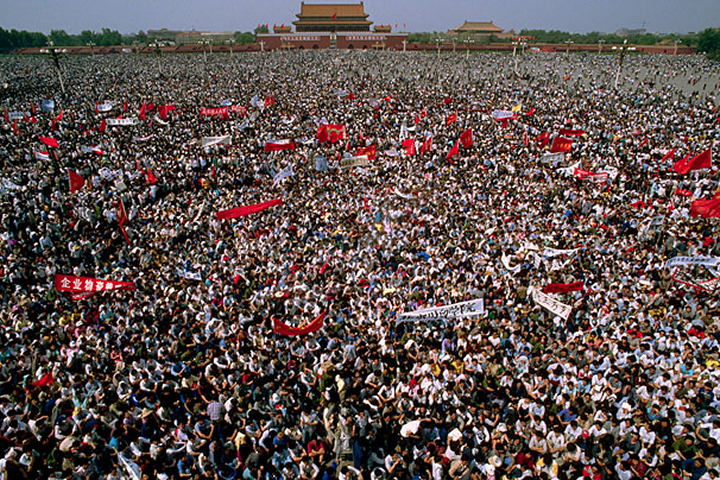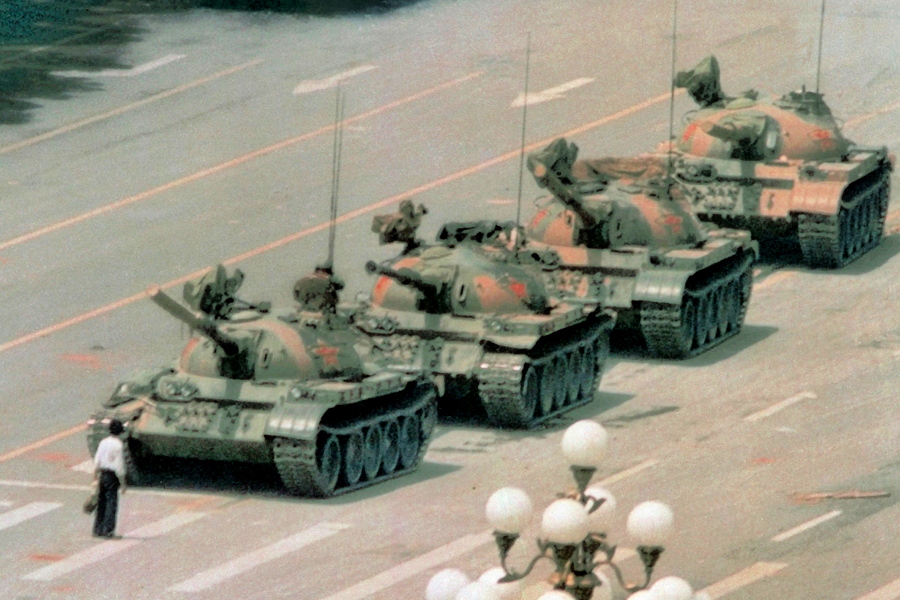1989 Tiananmen Square Event/Massacre
 Decades ago, in a dark night from the late night to the subsequent early morning on 3 June 1989,
thousands of protesters battled armoured carriers and armed soldiers behind barricades of fences and buses
on the vast square of Tiananmen in Beijing, China. No outsiders knew the exact number of deaths that night.
The official figures were 200-300 but the number could be much higher according to unofficial sources.
Decades ago, in a dark night from the late night to the subsequent early morning on 3 June 1989,
thousands of protesters battled armoured carriers and armed soldiers behind barricades of fences and buses
on the vast square of Tiananmen in Beijing, China. No outsiders knew the exact number of deaths that night.
The official figures were 200-300 but the number could be much higher according to unofficial sources.
Photo: Lam Yik Fei/Getty Images
The even had actually been brewing for months or even for a couple of years. After the chaos of the Cultural Revolution,
China embarked on the reform of her backward economic system under Deng Xiaoping's "Theory of Building Socialism with Chinese Characteristics"[1].
In a decade, China achieved substantial progress - the 1980 GDP was doubled and the people had enough food and clothing, but the communist grip on the society was
loosened. Hu Yabang, General Secretary of the Chinese Communist Party, was dismissed because of his lenient stance on dissident students in 1987.
Meanwhile, the fast pace of reform had brought rising inflation, rampant corruption in local and state-owned enterprises (though petty compared to today's standard).
When Hu Yabang suddenly died of heart attack on 15 April 1989, his pro-democracy supporters - the students, intellectuals and party sympathizers
- joined ranked to cry out their concerns and grievances.
Timeline
The following timeline describes the event over the short few weeks [2]:15 April - Small groups of university students gathered at Tiananmen Square.
16 April - Similar gatherings of students occurred in Xian and Shanghai.
17 April - Hundreds of students marched to the eastern gate of the Great Hall of the People (part of the square) in the afternoon. Soon, more students and workers joined the mourning. In the night thousands of students had joined the mourners. Various speakers made impromptu speeches about their concerns of social problems. Gradually, the students started to draft a list of pleas and suggestions to give to the government.
18 April - One group of students marched to the Great Hall of the People and started a sit-in to present the list of pleas. Another group moved to Zhongnanhai complex (the central government building) to demand to see the government leaders.
20 April - The police employed batons to disperse the students to resume the normal activities at Zhongnanhai. This minor clash was reported by the Chinese media and impelled the momentum of the protest[3].
21 April - About 100,000 students marched on Tiananmen Square.
22 April - The square was closed off for Hu's memorial service in the Great Hall of the People.
26 April - Following an internal speech by Deng Xiaoping, the People's Daily published a front-page editorial about turmoil and civil unrest and warned sternly of a crackdown.
27 April - About 50,000 students assembled on the streets in Beijing to reject the editorial.
In the period before 4 May, the students organized their own unofficial student associations. The demonstration gradually evolved from complaints about corruption and inflation into liberalization demands for freedom of the press and democratic reform of the government.

4 May - 100,000 demonstrators marched in Beijing to demand a televised dialogue between the government leaders and student-elected representatives.
13 May - The students gathered again at Tiananmen Square and started a hunger strike.
15 May - Soviet Union President Mikhail Gorbachev began the state visit to China. The welcome arrangement at Tiananmen Square was shifted to the airport.
18 May - Premier Li Peng invited student leaders for a televised talk at the Great Hall. At the end, the two sides could only agree that it was a meeting and not a dialogue.
Photo: Jeff Widener/AP Images
19 May - General Secretary Zhao Ziyang went to the square to make an unofficial speech to urge the students to end the hunger strike.
His futile effort was apparently not appreciated by the hardliners in the Party.
In that day, Li Peng delivered an important speech on behalf of Party Central Committee and State Council at a meeting of cadres from party, government and army.
Li Peng described the anarchic state in Beijing and the traffic jams. He reported that the demonstration had spread and interfered the
functions of local governments and mentioned about the interruption of the railway and trunk road traffic.
He charged, "A handful of people, who were plotting and inciting unrest from behind the scene, mistook the tolerance as weakness of the party and government.
They continued to spread rumours to mislead and fool the masses and to worsen the situation.
This made the grim situation in the capital and many parts of the country become increasingly acute.
We are now forced to take decisive and resolute measures to put an end to the turmoil."
20 May - Martial law was formally declared for the city of Beijing with the approval by Deng and the other Party elders.
The PLA army's entries were nevertheless blocked by the students and the residents of the city.
23 May - The PLA troops were pulled back to the outskirts. The students formed the
Alliance to Protect the Constitution to accommodate the various groups.
24 May - The Tiananmen Square Command Headquarter was formed and Miss Chai Ling,
was elected the commander of the influential headquarter.
27 May - The Alliance voted unanimously to propose the end of the occupation of the square on May 30.
Student leaders - Wang Dan and Chai Ling submitted their resignation.
28 May - The proposal was announced to the students, but the students rejected it.
30 May - The students erected a 10-metre statue of the Goddess of Democracy in the square to symbolize the protest.
 3 June - PLA troops were mobilized again and moved into the centre of the city .
About 10:00 P.M. columns of armoured carriers and army trucks loaded with soldiers moved toward the square.
The soldiers shot aimlessly into the adjacent apartments and many bystanders were hit by stray bullets.
Meanwhile, the protesters set fire to buses and built barricades to stop the troops.
Besides stones, the protesters threw Molotov cocktails at the PLA vehicles.
The armoured carriers tried to smash through or roll over the barricades, and some carriers had plowed into the crowd.
3 June - PLA troops were mobilized again and moved into the centre of the city .
About 10:00 P.M. columns of armoured carriers and army trucks loaded with soldiers moved toward the square.
The soldiers shot aimlessly into the adjacent apartments and many bystanders were hit by stray bullets.
Meanwhile, the protesters set fire to buses and built barricades to stop the troops.
Besides stones, the protesters threw Molotov cocktails at the PLA vehicles.
The armoured carriers tried to smash through or roll over the barricades, and some carriers had plowed into the crowd.
Photo: Peter Turnley/The Guardian
4 June - At 1:00 AM the troops began to encircle the square. Gun shots were heard and the soldiers were said to have been shooting into the crowd.
At 3:00 AM the troops completely sealed the square except the southeastern corner for exit.
At 4:00 AM Two hunger strikers sought the PLA commanders to ask the permission to withdraw from the square.
At 5:00 AM Several thousands of protesters evacuated from the square.
By 5:30 AM the PLA troops secured the square.
Top | Bottom of Page
Post-Tiananmen Event
After the month-long protest for democracy by students and the precipitated bloody scene at Tiananmen, the power-struggle between the liberal and the hardliner factions continued until General Secretary Zhao was formally disgraced and was put under house-arrest until his death in 2005. His key supporters were also purged or jailed. Some of the student leaders were imprisoned and some escaped overseas. Deng, who had the support of PLA [4], remained as Chairman of the Central Military Commission until his voluntary retirement in November 1989 and Premier Li stayed at his post until 1998. One winner in this struggle is Jiang Zemin, the mayor of Shanghai, who quelled the protest without blood shed; he was quickly promoted to the post of General Secretary (1989-2002). Later he had the paramount post of Chairman of military commission (1989-2004) and the post of President of the republic (1993-2003). Then China was back on the reform course albeit at a gradual moderate pace.After two decades, this steady course had revealed many astonishing results in this experiment of social restructure. A 2009 article (www.china.org.cn) describes "the Chinese people have emancipated their minds and updated their ideas as well. Chinese reforms have deepened gradually, with reforms complementing the opening-up policies." In 2017, China has succeeded in her stride to modernization and her gross domestic product is expected overtake that of United States of America soon; however, democracy has taken a backseat in China because of global unrest and risky geo-political situations.
Notes
[1] In 1987, China was still a backward and poor country. For instance, most households did not have a telephone and have to receive and make a call at the commune office. Besides the official media - TV, radio and newspapers, ordinary citizens could only learn of uncensored developments through mouth- to-mouth communication and probably from short-wave radio.[2] The current article has been written based on memory of the event through my personal visits in China and through the broadcasts of TV and radio (1988-1989) and the details supplemented by new documents available now.
[3] The police personnel were often unarmed and relied on persuasion and neighbourhood watch techniques to control China's huge population. There were no anti-riot squads, and the prefectural police generally followed the model role of People's Liberation comrades.
[4] The following is an extract of Deng Xiaoping's speech in paying tribute to the fall soldiers of Martial Law Units on 9 June 1989:
"The problems we face in the course of reform are far greater than those we encounter in opening our country to the outside world. In reform of the political system, we can affirm one point: We will persist in implementing the system of people's congresses rather than the American system. ... We must resolutely implement the series of line, principles, and policies formulated since the third plenary session of the Eleventh CPC Central Committee. We should conscientiously sum up our experiences, persevere with what is correct, correct what is wrong, and do a bit more where we have lagged behind. In short, we should sum up the experiences of the present and look forward to the future."
[5] Pro-Democracy Movement by Hong Kong residents (May 1989 - Central District, HK):